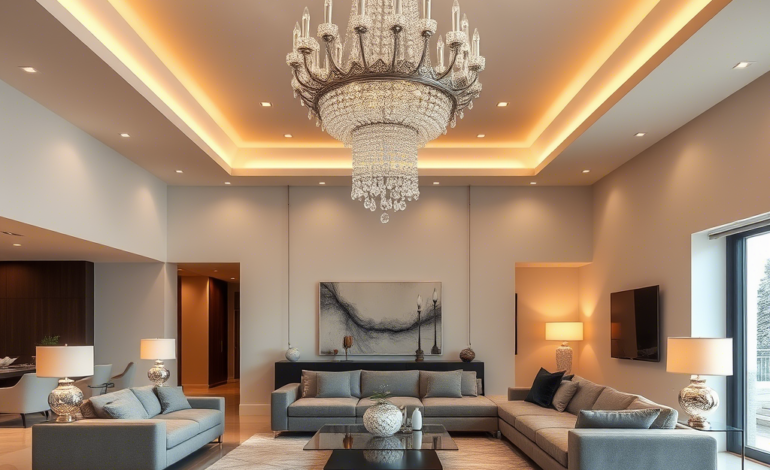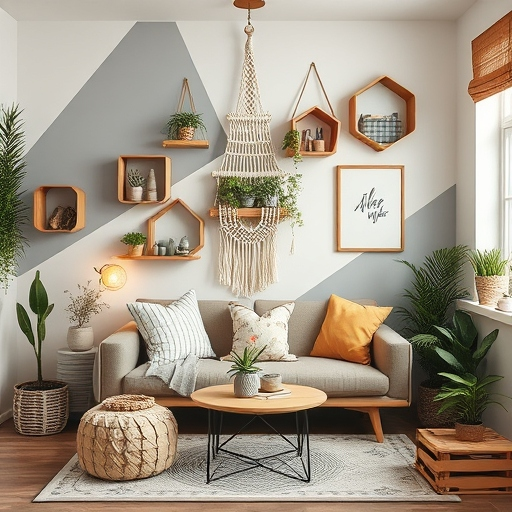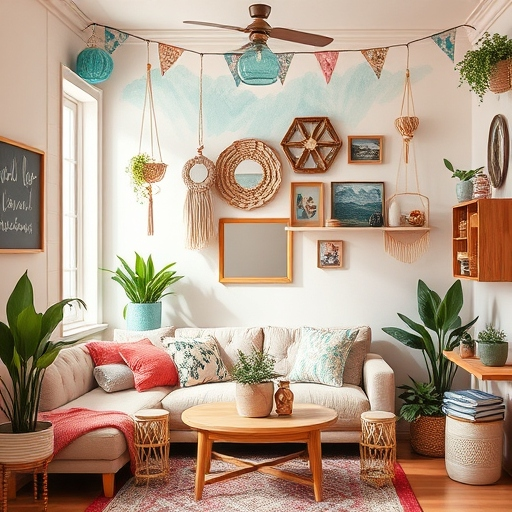
Modern Geometric Wood Craft: 10 Easy Projects for Stunning Home Decor
Modern geometric wood craft is a contemporary approach to woodworking that emphasizes clean lines, precise angles, and symmetrical patterns. By combining traditional woodworking techniques with modern design principles, artisans create functional and decorative pieces that showcase the natural beauty of wood through geometric shapes. This art form has gained popularity for its ability to blend seamlessly with both minimalist and eclectic interior styles.
Picture this: you’re strolling through a chic home decor store, and your gaze falls upon a breathtaking wooden coffee table. Its surface is a mosaic of interlocking triangles and hexagons, each piece of wood carefully cut and fitted to create a mesmerizing pattern. You can’t help but run your fingers over the smooth surface, marveling at the craftsmanship. Welcome to the world of modern geometric wood craft – where art meets function, and where you, yes you, can create your own masterpieces!
In this guide, we’ll take you on a journey through the fascinating realm of modern geometric wood craft. You’ll uncover its origins, discover the tools you’ll need, learn basic techniques to get started, and even get step-by-step instructions for your first project. Whether you’re a total beginner or have some woodworking chops, this article will spark your creativity and equip you with the know-how to dive into this rewarding craft. So, grab your safety goggles, and let’s get crafting!
What is Modern Geometric Wood Craft?
Modern geometric wood craft is all about using geometric shapes—think triangles, squares, or hexagons—to create stunning wooden designs. Unlike traditional woodworking, which might feature flowing curves or ornate carvings, this style thrives on simplicity, precision, and a touch of mathematical magic. The result? Pieces that are eye-catching yet practical, from wall art to furniture.
At its heart, modern geometric wood craft involves cutting wood into specific shapes and piecing them together like a puzzle. You might craft a flat panel for decor or build a 3D object like a lamp or sculpture. The trick is balancing beauty and utility, letting the geometric patterns shine while keeping the piece functional.
What sets this craft apart is its clever use of negative space. Leaving gaps or open frameworks lets light and shadow play across your work, adding depth and drama. Plus, the wood you choose—whether it’s the warm tones of walnut or the light hues of maple—can make those geometric designs pop even more.

The History and Evolution of Geometric Wood Craft
Geometric designs in woodworking aren’t new—think ancient Egyptian chairs or intricate Islamic patterns. But modern geometric wood craft as we know it kicked off in the mid-20th century, riding the wave of design movements like Bauhaus and Minimalism. These styles showed the world that simple shapes could pack a big punch.
By the 1960s and 70s, DIY fever and modular furniture trends gave geometric wood craft a boost. Folks loved the idea of making stylish, affordable pieces with basic tools, and geometric designs fit the bill perfectly. Fast forward to today, and tools like laser cutters and CNC machines have taken modern geometric wood craft to new heights, offering precision that’s almost mind-blowing.
Even with tech advancements, many crafters stick to hand tools for that hands-on vibe. It’s this mix of old-school skills and modern flair that keeps modern geometric wood craft fresh and approachable for everyone.
Essential Tools and Materials for Beginners
Ready to jump into modern geometric wood craft? First, you’ll need some basic gear. Here’s what every beginner should have:
- Measuring and Marking Tools:
- Ruler or measuring tape
- Square (for perfect right angles)
- Compass (for circles and arcs)
- Protractor (for nailing those angles)
- Cutting Tools:
- Hand saw or miter saw (straight cuts)
- Coping saw or scroll saw (curves)
- Utility knife (fine details)
- Joinery Tools:
- Wood glue
- Clamps (various sizes)
- Nails or screws (optional)
- Finishing Tools:
- Sandpaper (smooth it out)
- Wood stain or paint (optional flair)
- Clear coat or varnish (protection)
- Safety Gear:
- Safety goggles
- Dust mask
- Ear protection (for power tools)
Now, let’s talk wood. Your choice depends on your project and budget. Check out this handy table:
| Wood Type | Characteristics | Best For |
|---|---|---|
| Pine | Soft, light, cheap | Practice, indoor decor |
| Oak | Hard, durable, bold grain | Furniture, tough items |
| Maple | Hard, fine grain, light | Detailed designs |
| Walnut | Hard, rich color, smooth | Luxe art pieces |
| Plywood | Stable, versatile, affordable | Big panels, structure |
For starters, pine’s your friend—easy to cut and wallet-friendly. As you level up, hardwoods like oak or walnut add durability and pizzazz.
Basic Techniques and Design Principles
Success in modern geometric wood craft hinges on a few key skills and design tricks.
Cutting Accurate Shapes:
Precision is everything. Use a sharp saw, follow your lines slowly, and for tricky angles, lean on a miter saw or box for crisp results.
Joining Pieces:
You’ve got options here:
- Butt Joints: Quick and easy, but glue or nails help.
- Miter Joints: Perfect for frames, giving clean corners.
- Lap Joints: More glue surface, extra sturdy.
Play around to find your favorite method.
Design Principles:
Keep these in mind:
- Symmetry: It’s pleasing to the eye and simpler to build.
- Repetition: Repeating shapes creates flow.
- Contrast: Mix wood types or finishes for pop.
- Scale: Match shape size to your project’s vibe.
Step-by-Step Guide to Creating Your First Piece
Let’s make a geometric wooden coaster—a perfect intro to modern geometric wood craft.
What You’ll Need:
- Thin wood board (1/4 inch plywood works)
- Ruler
- Pencil
- Hand saw or scroll saw
- Sandpaper
- Wood glue
Steps:
- Design It: Pick a shape—hexagons are beginner-friendly. Draw one on your wood with 3-inch sides using your ruler.
- Cut It: Saw along your lines carefully. Repeat for more coasters if you’re feeling ambitious.
- Sand It: Smooth edges with sandpaper for a pro finish.
- Assemble (Optional): For a single shape, you’re done. Want a pattern? Glue smaller shapes onto a base.
- Finish It: Add varnish once dry for shine and protection.
Boom! Your first modern geometric wood craft piece is ready.
Advanced Techniques and Inspiration
Ready to level up? Try these:
- Inlay Work: Embed contrasting woods for bold patterns.
- 3D Shapes: Build polyhedrons or domes for wow factor.
- Digital Tools: Laser cutters or CNC machines for insane detail.
Need ideas? Look at nature (think honeycombs), architecture, or math-inspired designs like tessellations. For more, check out the Woodworkers Guild of America.
Frequently Asked Questions
What’s the difference between modern geometric wood craft and traditional woodworking?
Modern geometric wood craft loves sharp lines and math-inspired patterns, rooted in today’s design trends. Traditional woodworking often goes for curves and classic carvings. Both need skill, but the modern style’s simplicity makes it a fun entry point.
Do I need math skills for geometric wood designs?
You don’t need to ace geometry for modern geometric wood craft—basic shapes work fine. Simple patterns skip the heavy math, though a little number crunching can spice things up later. It’s more about creativity than equations.
Which woods work best for geometric projects?
Your modern geometric wood craft wood pick depends on your goal. Pine’s cheap and easy for newbies; oak or walnut bring strength and beauty for bigger stuff. Plywood’s a solid, budget-friendly all-rounder.
How do I start modern geometric wood craft as a beginner?
Grab a saw, ruler, and sandpaper to kick off modern geometric wood craft. Try a basic project like a coaster and follow steps like the ones above. Mistakes are okay—they’re how you learn!
Are there online spots to learn more about this craft?
Tons! Sites like Instructables, YouTube woodworking channels, and Reddit’s r/woodworking are goldmines for modern geometric wood craft. Instagram and Pinterest also dish out killer design inspo.
Can I sell my modern geometric wood craft pieces?
Yes! Sell your modern geometric wood craft on Etsy, craft fairs, or your own site. Build a portfolio as you improve, and price based on time and materials.
What safety tips should I follow?
Safety first in modern geometric wood craft: wear goggles for eye protection, a mask for dust, and ear gear for noisy tools. Keep your space tidy and take it slow with cuts. Stay sharp, stay safe.
How can I use modern geometric wood craft in my home?
Add flair with modern geometric wood craft shelves, wall art, or tables. Mix finishes to match your style—it works with modern or classic vibes. It’s versatile and oh-so-stylish.

Conclusion
Modern geometric wood craft is your ticket to blending creativity with woodworking flair. With a handful of tools and some basic know-how, you can craft pieces that dazzle and delight. Whether it’s sprucing up your space or sharing your work, this craft’s got endless potential. So, grab some wood, start small, and let your geometric genius shine! Got a project in mind? Drop it in the comments—we’d love to see what you create!
Key Takeaways:
- Modern geometric wood craft mixes old-school woodworking with modern, shape-driven design.
- Start with basic tools like saws and rulers, plus safety gear.
- Try simple projects like coasters to get the hang of it.
- Level up with inlays or 3D builds as you grow.
- Tap into online communities for tips and inspiration.





